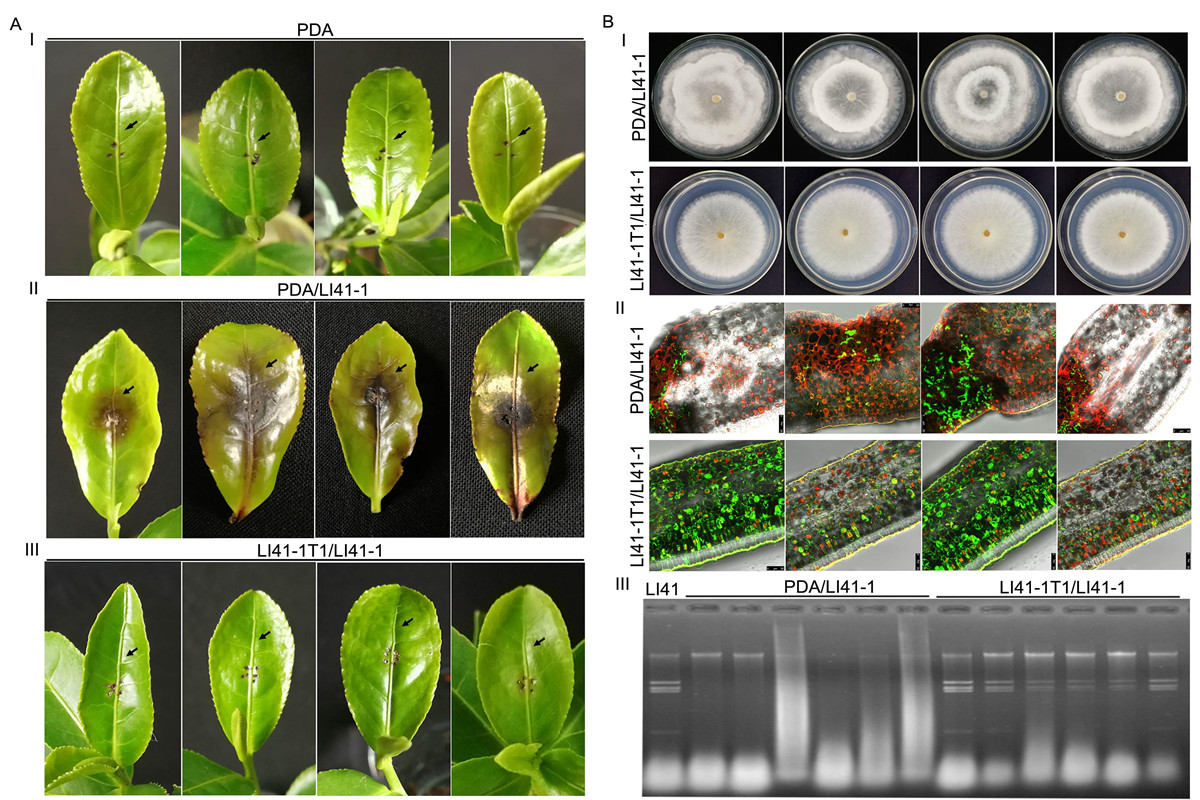南湖新闻网讯(通讯员 李雪培)近日,我校植物科学技术学院果树病理团队发现一种新的金色病毒(命名为茶拟盘多毛孢金色病毒1,Pestalotiopsis theae chrysovirus 1, PtCV1)可以介导真菌营养型的转变。感染病毒可使寄主真菌由致病菌转换为内生真菌,脱除病毒可以使内生真菌转变为致病菌,该内生态菌株可以介导植物对同种致病态菌株真菌产生强烈的防病作用。该研究发表在The ISME journal。

图1 茶拟盘多毛孢金色病毒1对茶拟盘多毛孢生物学影响及介导的防病作用
通常认为,真菌在植物内以单一的生活营养状态存在:寄生、腐生或共生方式生存。前者为植物病原真菌,可以引起作物病害,后者为内生真菌,可与植物互惠共生或共栖共生,增强寄主的抗逆能力。之前较多研究表明环境和营养的变化可以暂时影响真菌的营养状态变化,但自然界是否存在一些生物因子可以逆转同一种真菌的营养状态研究较少。本研究发现的茶拟盘多毛孢金色病毒1(Pestalotiopsis theae chrysovirus 1, PtCV1)有4条dsRNA链,大小分别为3391、2798、2599和932 bp,各包含一个独立的开放阅读框(ORF),分别编码依赖RNA的RNA聚合酶、外壳蛋白、编码甲基转移酶及功能未知蛋白,透射电镜观察显示PtCV1包被在大小为30.1~39.8 nm的球形病毒粒体里面。当用PtCV1转染或传播给正常的茶拟盘多毛孢菌株时候,可以介导其从致病菌变成内生菌,而将无致病力的菌株脱去PtCV1时,内生性的菌株则重新恢复了致病性,转染了PtCV1的菌株具有显著的抗病能力,可以保护接种的叶片免受致病菌株的危害。该研究明确一种RNA病毒生物因子可以调控真菌致病/内生性营养类型的相互转换,揭示RNA病毒在真菌与植物寄生和内生的复杂关系中发挥重要的调节作用,为利用RNA病毒介导致病真菌转变为内生菌用于病害的防治奠定了理论基础。
华中农业大学植物科学技术学院硕士研究生李雪培和周玲玲为论文共同第一作者,徐文兴教授为论文通讯作者。该研究得到了国家自然科学基金和中国热带农业科学院环境与植物保护研究所基础研究基金等项目的资助。
论文链接:https://doi.org/10.1038/s41396-021-00892-3
英文摘要:Fungi are generally thought to live in host plants with a single lifestyle, being parasitism, commensalism, or mutualism. The former, known as phytopathogenic fungi, cause various plant diseases that result in significant losses every year; while the latter, such as endophytic fungi, can confer fitness to the host plants. It is unclear whether biological factors can modulate the parasitic and mutualistic traits of a fungus. In this study, we isolated and characterized a mycovirus from an endophytic strain of the fungus Pestalotiopsis theae, a pathogen of tea (Camellia sinensis). Based on molecular analysis, we tentatively designated the mycovirus as Pestalotiopsis theae chrysovirus-1 (PtCV1), a novel member of the family Chrysoviridae, genus Alphachrysovirus. PtCV1 has four double-stranded (ds) RNAs as its genome, ranging from 0.9 to 3.4 kbp in size, encapsidated in isometric particles. PtCV1 significantly reduced the growth rates of its host fungus in vitro (ANOVA; P-value < 0.001) and abolished its virulence in planta (ANOVA; P-value < 0.001), converting its host fungus to a non-pathogenic endophyte on tea leaves, while PtCV1-free isolates were highly virulent. Moreover, the presence of PtCV1 conferred high resistance to the host plants against the virulent P. theae strains. Here we report a mycovirus that modulates endophytic and phytopathogenic fungal traits and provides an alternative approach to biological control of plant diseases caused by fungi.
审核人 徐文兴
